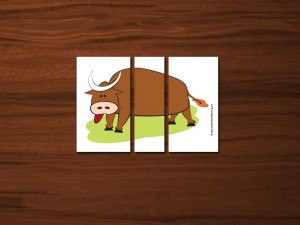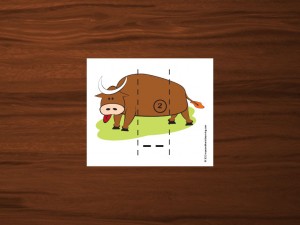The Silly Bull Syllable Kit can be used during the introduction of new concept section of the lesson to help students discover sounds and attributes of the new concept.
Auditory Discovery
One of the first steps in introducing a new sound is to do Auditory Discovery. You read a short list of words, and your student repeats them and tries to figure out what sound is the same in all the words. The Silly Bull head, body and tail part cards can be used to support students in working this out.
Tell the student they have to figure out if the Silly Bull head, body or tail is the same in all the words you are about to read. Read a word and have the student say it back, repeating until you have gone through all in your list of words with the new concept.
If they cannot correctly identify which part is the same, read each word again, and have the student sound out each word’s head/body/tail on the Silly Bull parts. Once they have figured out which part (head, body or tail) is the same, then ask them what that sound is (not what letters). Tell the student to see whether they’re right by having them again sound out each word’s head/body/tail, listening for the Silly Bull part that they identified as being the same. I have students do this regardless of whether they got it right or wrong, so that they can be the ones to confirm whether they answered correctly!
If you are introducing a sound that can go either on the head or the tail, and you are doing both in same lesson, do auditory discovery first with a list of words on the head (stiff, stop, stab), then repeat with a list of words with it on the tail (best, fast, lost).
Note that vowel sounds always go on the body, even if its one that comes at the end of a word(such as ay). While this may seem a bit confusing because “ay” comes at the “end” of a word, remember that we are trying to be consistent with segmentation within the syllable (just like in the blending drill, where the “ay” card goes in the middle, not the ending pile.) Likewise, an open syllable is also one with “no tail”.
New Syllable Type
If this is the first lesson that introduces a new syllable type (silent-e, vowel team, etc.), use the Silly Bull syllable type picture card to explain the new syllable type. This will introduce them to what the syllable type looks like and its distinguishing features, so they will be familiar with the picture card for the new syllable type in subsequent lessons when you review and use the syllable type cards.
This post is part of a series of articles on how to get the most out of your Silly Bull Kit:
Silly Bulls: head-body-tail segmentation
Silly Bulls and the Blending Drill
Silly Bull Syllable Type Cards
Silly Bulls and Introducing New Concepts (you are here!)


